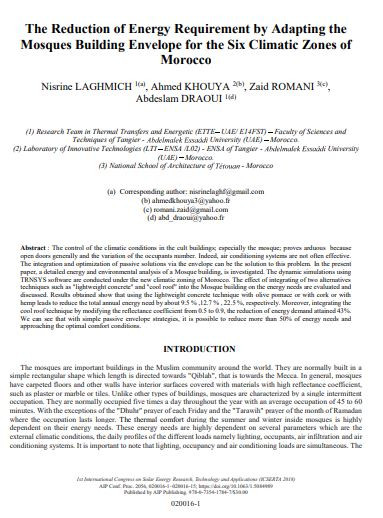
The control of the climatic conditions in the cult buildings; especially the mosque; proves arduous because open doors generally and the variation of the occupants number. Indeed, air conditioning systems are not often effective. The integration and optimization of passive solutions via the envelope can be the solution to this problem. In the present paper, a detailed energy and environmental analysis of a Mosque building, is investigated. The dynamic simulations using TRNSYS software are conducted under the new climatic zoning of Morocco. The effect of integrating of two alternatives techniques such as “lightweight concrete” and “cool roof” into the Mosque building on the energy needs are evaluated and discussed. Results obtained show that using the lightweight concrete technique with olive pomace or with cork or with hemp leads to reduce the total annual energy need by about 9.5 % ,12.7 % , 22.5 %, respectively. Moreover, integrating the cool roof technique by modifying the reflectance coefficient from 0.5 to 0.9, the reduction of energy demand attained 43%. We can see that with simple passive envelope strategies, it is possible to reduce more than 50% of energy needs and approaching the optimal comfort conditions.
Laghmich, Nisrine, Ahmed Khouya, Zaid Romani, and Abdeslam Draoui. “The reduction of energy requirement by adapting the mosques building envelope for the six climatic zones of Morocco.” In AIP Conference Proceedings, vol. 2056, no. 1. AIP Publishing, 2018.
I agree to the terms outlined below:
You agree to upload and assign Mosqpedia Database the rights to use the content worldwide and in perpetuity across all current and future media platforms. Mosqpedia Database may edit, copy, adapt and translate your contribution.
The content will be distributed under the Creative Commons Attribution-Deed – Attribution-NonCommercial-NoDerivatives 4.0 International – Creative Commons
All data will be stored in line with data protection regulations.